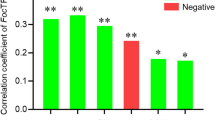Abstract
The effect of foliar application of 2% urea and 0.6% benomyl on changes in colonization of the rhizosphere by microorganisms and of roots by the fungusGaeumannomyces graminis (Sacc.)Arx etOlivier var.tritici Walker was followed in vegetation glass-house experiments. Treatment with a urea solution resulted in increased counts of bacteria (82 %),Pseudomonas fluorescens (46 %),Agrobacterium sp. (31 %) and antagonistic bacteria with respect to the used fungus isolate and in a decreased occurrence of micromycetes (63 %). Treatment of wheat with a benomyl solution resulted in an increased count of bacteria (43 %) and a decreased occurrence ofP. fluorescens (16 %),Agrobacterium sp. (50 %) and fungi (67 %). After treatment with both compounds the infection of roots byG. graminis considerably decreased as compared with untreated plants. The results are discussed from the point of view of the effect of application of the studied compounds to upper parts of wheat on the microflora colonizing its roots.
Similar content being viewed by others
References
Balasubramanian A., Rangswami G.: Influence of foliar application of chemicals on the root exudations and rhizosphere microflora ofSorghum vulgare andCrotalaria juncea.Folia Microbiol.18, 492 (1973).
Barcley C. A., Crosse J. A.: Population of aerobic bacteria associated with the roots of apple and cherry plant.J. Appl. Bact.37, 415 (1974).
Čatská V., Vraný J.: Rhizosphere mycoflora of wheat after foliar application of chlorocholine chloride, urea and 4-chloro-2-methylphenoxyacetic acid.Folia Microbiol.21, 168 (1976).
Cook R. J., Rovira A. D.: The role of bacteria in the biological control ofGaeumannomyces graminis by suppressive soils.Soil Biol. Biochem.8, 269 (1976).
Katznelson H.: Nature and importance of the rhizosphere, p. 187 in F. A. Baker, W. C. Snyder (Eds):Ecology of Soil-Borne Plant Pathogens. Univ. Calif. Press, Berkeley 1965.
Lasík J., Staněk M., Vančura V., Wurst M.: Effect of Bacterial Polysaccharides on the Growth ofGaeumannomyces graminis var.tritici and wheat roots.Folia Microbiol.24, 262 (1979).
Martin J. R.: Use of acid rose bengal and streptomycin in the plate method for estimating soil fungi.Soil Sci.69, 215 (1950).
Müller G.:Boden-Biologie, p. 261. VEB-Fischer, Jena 1965.
Němec A. and coworkers:Botanical Microtechnique. Publ. House Czechosl. Acad. Sci., Prague 1962.
Parr J. F.:Soil and Fertilizer Nitrogen Research. A Projection into the Future, p. 36. Tennessee Valley Auth. Wilson, Dam, Alabama 1964.
Author information
Authors and Affiliations
Rights and permissions
About this article
Cite this article
Vraný, J., Staněk, M. & Vančura, V. Rhizosphere microflora and colonization of wheat roots byGaeumannomyces graminis var.tritici after foliar application of urea and benomyl. Folia Microbiol 25, 476–482 (1980). https://doi.org/10.1007/BF02897213
Received:
Issue Date:
DOI: https://doi.org/10.1007/BF02897213




